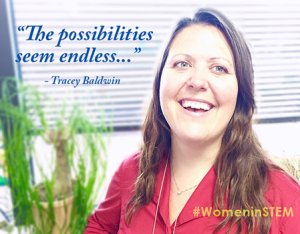Women in STEM: Tracey Baldwin
April 24, 2015
By Leslie Goldman
According to U.S. Census Bureau statistics, women in fields commonly referred to as STEM (science, technology, engineering, mathematics) made up only 25 percent of the STEM workforce in 2011. However, women earn more college and graduate degrees than men, and they make up half the national workforce. So, why aren't more women going into STEM careers? In this series of interviews of staff at National Ecological Observatory Network (NEON), we will feature some of the amazing female STEM professionals at NEON and ask them to talk about how they found their way into the world of STEM and what words of advice they have to give the next generation of girls in STEM.
Meet Tracey Baldwin
I’m Tracey, a Field Operations Manager for the Central Plains (Domain 10) and the Southern Rockies and Colorado Plateau (Domain 13). My office is responsible for running eight NEON field sites year round. My responsibilities include: managing full-time and seasonal field staff in collecting sample collections and maintaining sensors that collect data, helping with the permitting of our sites, and managing a fleet of trucks and lab equipment, etc. I also manage the budget for our domain operations - with a constant goal of optimizing our performance to yield the best data, while running the most efficient lab. And if that isn’t enough, I keep current in the field by reading protocols and science journals, attending research conferences and discussing possible science collaborations for NEON.
Tell us about something cool you recently did for work
I had the opportunity to show the NEON flux tower in Rocky Mountain National Park to a group of scientists that were interested in exploring a question about ammonia transport from the eastern plains of Colorado to the top of the mountains within the park. We talked science for at least an hour, and I was able to describe all of the wonderful infrastructure the NEON project will be making available to them. By the end of the conversation, the possibilities of what we could do together seemed endless.
What inspires you to work for NEON?
Those endless possibilities that come from a well designed and developed project that offers openly available data!
Did you always know you were interested in STEM stuff?
I knew early on in life that I was good at math and science from all those primary school teachers along the way. That led me to attend big grown up lectures as a young undergraduate on topics like robotic arm development and swirling air masses in the Costa Rican Rainforest. It was in one of these lectures that sparked the idea of science taking me to interesting places. I applied for the NSF Research Experience For Undergraduates (REU) program, and when I got in, I packed my bags and headed off to the North Slope of Alaska. Then it clicked - science could not only take me to interesting places to see interesting things and meet interesting people, it could also be a career! I was hooked.
Which parts of STEM are relevant to what you do - science, technology, engineering, and mathematics?
SCIENCE!
What relevant STEM schooling have you had?
BS in Biology from Florida State University, MS in Biology from Florida International University, and Project Management Professional (PMP) certification from Project Management Institute
Any words of wisdom for girls or young women about STEM careers/schooling?
Think of the possibilities! There are other career options besides being a teacher, doctor, or astronaut. While those are wonderful choices, the possibilities seem endless when you sit down and dream of the things you can do with a science education - you could be an environmental lawyer, or a fighter for wildlife conservation, either close to home or far away. You could be the special effects artist for a film set in deep space, or a physicist staring at the stars from the south pole. You could be a naturalist on a ship sailing to far off places, or even a manager of science operations for a giant project like NEON!
About the NEON #WomeninSTEM series
Tracey Baldwin is just one of the many amazing STEM professionals that work at NEON. This series of staff spotlights will hopefully give women and girls some insight and inspiration about what it is like to be a STEM professional. NEON STEM-related positions include engineers, scientists, educators, computer scientists, system engineers and more. To learn about current career opportunities like being a Field Operations Manager or Field Technician, visit our Careers page. NEON also offers an annual summer internship program to give qualified undergraduates the opportunity to gain work experience in an interdisciplinary STEM environment.

